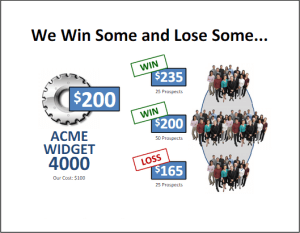Driving pricing improvement will almost always require people outside the pricing group…people who aren’t knee deep in pricing, all day, every day…to grasp some fairly esoteric pricing concepts. And while these other people and groups won’t have to develop expert knowledge, they will have to understand enough to help you achieve your objectives.
Let’s say, for example, that you’re laying a solid foundation by developing and implementing a price segmentation model based on relative willingness-to-pay under various circumstances. And of course, you’ll want the sales team to use this segmentation model to guide their pricing and discounting decisions.
So how do you explain something as complex as price segmentation to a sales team? Well…maybe you shouldn’t even try…not directly, anyway.
In the “Communicating Pricing Concepts” webinar, we make the point that when trying to convey pricing concepts to others, it’s not enough to simply regurgitate your own subject matter expertise. To be an effective “translator” you really need to combine your knowledge of the subject with knowledge of the audience.
So instead of explaining all the esoterica, technicalities, and jargon…stuff that’s really only meaningful and relevant to pricing practitioners…you might try “flipping the script” and making pricing segmentation all about them.
Here’s how that approach might play out with a sales team:
“As sales pros, you know that when you see a deal with X, Y, and Z, you’ll probably be able to charge more than on a deal with A, B, and C, right? Right.
Through experience, you’ve learned to use a bunch of tell-tale signs to help you figure out where you need to be—the type of customer, the type of product, the quantities involved, the likely competitive set, the lead times, and so on.
Well, together we’re going to nail down the tell-tale signs that make the most difference to how much we can charge under different circumstances.
Then, we’re going to use our historical data to figure out how much of a difference those attributes typically make.
And finally, we’re going bake those insights into the quoting system—so everyone can leverage the knowledge and experience of everyone else.”
Note that in this explanation, the closest we get to pricing jargon or esoterica is the term “attribute” and even that is first positioned as a “tell-tale sign.” By flipping the script, coming at it from their perspective, and relating it to things they’re already doing and are already familiar with, we’re able to explain the essence of price segmentation without ever using the technical terms.
Now, will the sales team know that they’re learning about price segmentation? Not unless you tell them. But does it matter? No, not really. After all, the most important thing is that they understand enough to help you do what you need to do. And very often, the technical terminology just gets in the way.
















